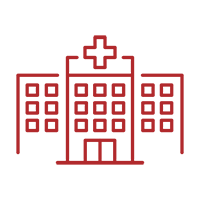The benefits of cloud-based services in healthcare are clear. But technology transformation alone does not necessarily create new value. Success depends on how effectively cloud capabilities can enable and further your healthcare organization’s business and IT strategies. To help sort through the main considerations, especially as applied to patient monitoring activities, we interviewed industry expert Cody Guest, Spacelabs VP, Informatics and Cloud Solutions.

What are the most prominent cloud-related trends in hospitals today?
Normalization, mainly. During a recent meeting with a healthcare system, for example, we learned they had somewhere in the range of 45 different vendors with cloud-based applications.
We also see that hospitals are starting to think more about how they structure the acquisition of cloud-based services because they’re concerned about interoperability. They want to see which systems are able to communicate with one another, which have like functionality, and they want to go through that process from a corporate perspective.

Where should an organization start when considering cloud-based services?
The thing I always end up asking customers is, what are the results you’re trying to achieve? Where are you trying to go?
People often jump to solutions without identifying the real problem and it only takes them halfway to their goal. In the end, you need to clearly understand the problem you’re trying to solve in order to find the right solution that will take you all the way there.

What are the most important issues to focus on?
I think the most important things are workflow and system interoperability. That’s what it really comes down to. A segregated system has limited functionality. If you can integrate cloud-based services into your overall system, into your EMRs and everything else, your possibilities become almost limitless.

What is the optimal way to integrate cloud-based services within a patient monitoring program?
Basically, there are two models to consider.
The first model puts all of the devices and pretty much everything else on-premises, with only a very few things running within the cloud. In this case you don’t end up backfilling data. Everything basically stays local. You might have some type of minimal semi-cloud functionality, like a service portal that provides access into the system, but basically everything’s going to be on-premises.
This is an OK model. But it makes things complicated as far as managing upgrades to the system and responding quickly to different types of events or correcting problems. It’s kind of cumbersome.
The second model, sometimes referred to as a hybrid model, blends on-premises functionality with cloud advantages in a more robust way.
In this scenario, all the core functionality of the patient monitoring system is built into the hardware, with backup mechanisms located in the cloud.
Should you lose access to the cloud for some reason, you lose your “nice-to-have” functionality, but you don’t lose your “have-to-have” functionality. Everything will continue to store, because it runs locally. And then, when everything’s restored from a connectivity standpoint, it’s going to push all that information back up to the cloud.
The hybrid model really has advantages in that it provides the desired comfort level to hospitals while also allowing for advancement of the technology itself.

What are the advantages of cloud-based systems in terms of security?
Nothing is ever completely unassailable, but the likelihood of a cloud-based system being hacked is highly unlikely.
Local systems are more susceptible to attack because they are accessed by users who are checking email, clicking on links, browsing the web, looking at videos and everything else.
We recently had a hospital customer that had a ransomware attack. Everything stopped working, except the patient monitors and our cloud-based SafeNSound analytics software.

What is the main challenge healthcare organizations face in managing cloud-based services?
Access, ironically. While accessibility is really easy in principle, vendor and security controls aren’t always fully considered.
Everybody is presenting hospitals with some type of cloud solution these days. We’ve seen situations where staff members just go online and get a service going. It’s a constant battle for IT departments.
But hospitals are dealing with this issue every single day, so they are getting processes in place around it.

How is the cloud accelerating new development at Spacelabs?
The cloud is allowing us to help drive collaborative communications among care teams and advance our technology at the same time.
It’s also providing analytics around what used to be unknown. We’ve always had vitals. We’ve always had alarms. We’ve always had information that we’ve been able to provide to the physician
in some form or fashion.
Now not only can we report on information, we can gather insights and make suggestions to help organizations modify their workflows for better patient care and make policy changes based on facts.
We can compile and apply information in new ways.

Can you be more specific?
Sure. It’s about having data and information, understanding how people are reacting to it, and the order and timeframes in which they’re reacting.
Take vitals, for example. We can look at the reactions that occurred based on vital information coming from a patient and correlate that with outcomes.
We’re able to create a timeline of activities that tells caregivers when they touched the monitor, when they acknowledged the alarm, when they adjusted the alarm, if and when the patient alarmed again, when the caregiver got into the room to acknowledge the alarm and when the phone call was made.

What are the main benefits of cloud-based services for Spacelabs customers?
Overall, cloud-based services can help care teams improve performance – and potentially patient outcomes – by accessing new capabilities with more convenience and speed.
The cloud also enables us to deliver new capabilities in smaller increments, which makes it easier for care teams to start taking advantage of performance innovations sooner rather than later.
In the end, rapid development cycles and quick, easy deployment make it possible for our customers to access and implement the innovations that are most useful for addressing their critical issues today.

What do you see as the future of cloud-based activities?
I see the speed and amount of information that can be stored in the cloud enabling us to get faster results and new decision-support insights by performing computations that used to be very complex and take a really long time.
For example, I think we’ll be able to help improve patient care through advanced artificial intelligence and machine learning that will help providers detect patterns and subtypes of abnormalities that they wouldn’t have seen in the past.
The cloud enables us to build larger databases and makes algorithms and machine learning more accurate because we have more information on which to base them.
In terms of technology, the main advancement I see is the speed at which we can process information and the amount of data being utilized.
There’s a long way to go to take full advantage of the cloud’s clinical and economic benefits. I think anybody within healthcare that doesn’t move toward the cloud in some form or fashion is going to be left behind.

CODY GUEST
VP, Informatics and Cloud Solutions, Spacelabs Healthcare
Cody Guest is responsible for the entire scope of information and technology management programs, including cloud-based strategies, at Spacelabs.
A successful entrepreneur who started his career as a monitor tech, Cody’s day-to-day experiences in hospitals and information systems expertise enable an uncommon perspective around applying data and information in new ways to help improve care team performance.
“The thing I always end up asking customers is, what are the results you’re trying to achieve? Where are you trying to go?”
“If you can integrate cloud-based services into your overall system, into your EMRs and everything else, your possibilities become almost limitless.”
“The hybrid model really has advantages in that it provides the desired comfort level to hospitals while also allowing for advancement of the technology itself.”
“Now not only can we report on information, we can gather insights and make suggestions to help organizations modify their workflows for better patient care and make
policy changes based on facts.”
“The cloud enables us to build larger databases and makes algorithms and machine learning more accurate because we have more information on which to base them.”